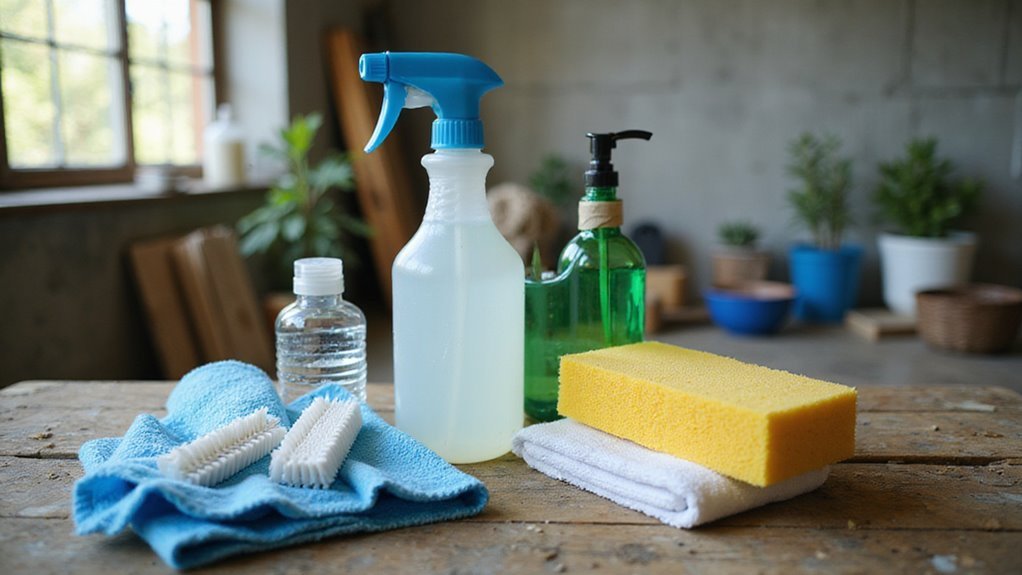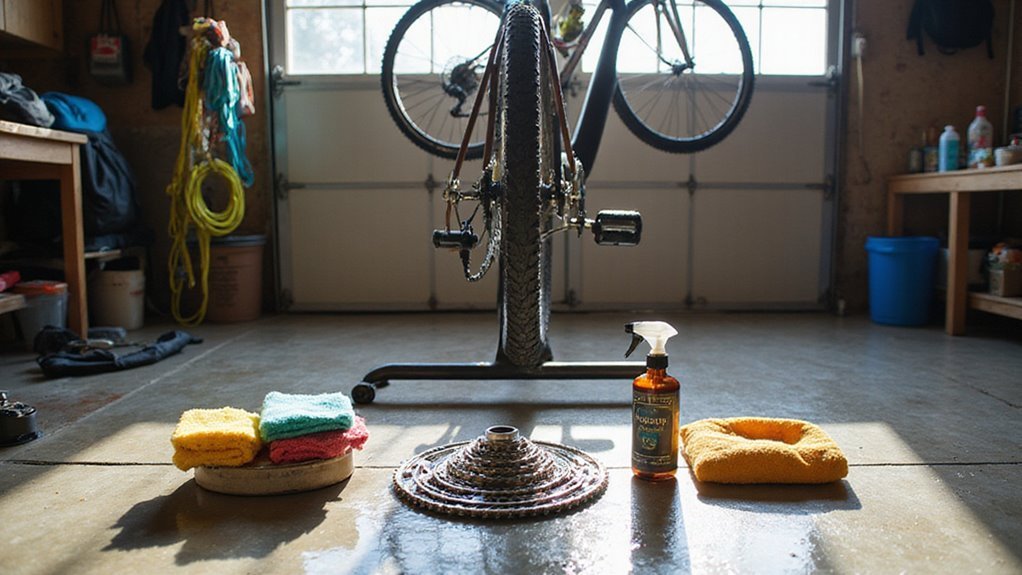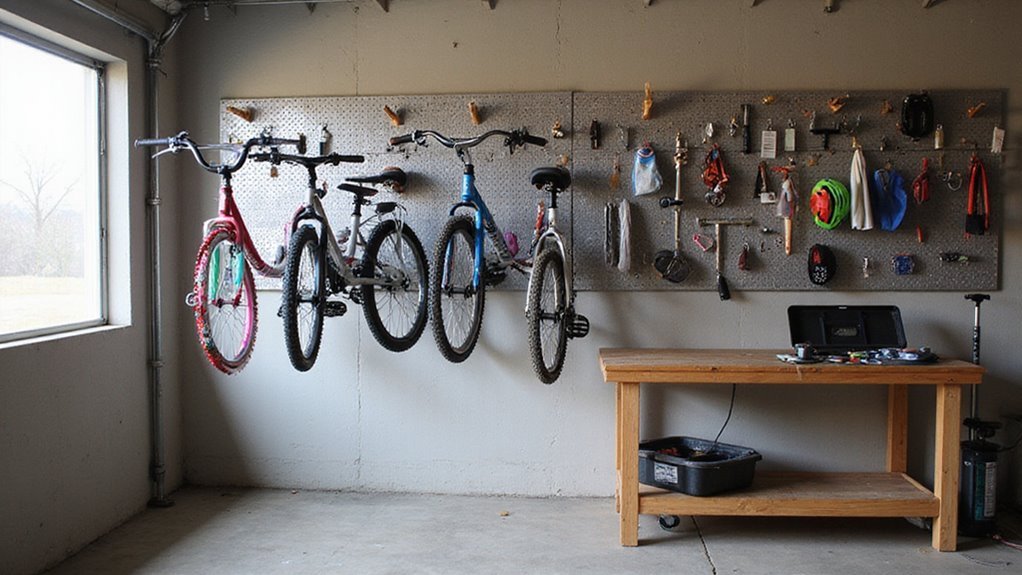Let’s talk about protecting our investment in outdoor gear, because nobody wants their $300 tent turning into a moldy mess after one cleaning mishap. We’ve seen too many perfectly good sleeping bags, backpacks, and technical garments ruined by harsh detergents and improper care. Proper cleaning isn’t just about keeping things fresh – it’s about extending gear life and maintaining critical performance features. What you’re about to learn will save you both money and headaches.
Basic Cleaning Supplies and Materials

Three essential cleaning supplies will form the foundation of your outdoor gear maintenance arsenal.
Let’s nail down what you’ll need: a mild detergent designed for soft fabrics (skip those harsh household cleaners), soft-bristled brushes for scrubbing boots and gear, and specialized cleaners with Durable Water Repellent for waterproof clothing. Remember, regular maintenance helps extend the lifespan of your gear, ensuring it performs at its best when you need it most.
We’re not messing around with just any cleaning supplies. Check those care instructions and stick to eco-friendly options that won’t compromise your gear’s integrity.
When washing, use the gentle cycle and ideal cleaning temperatures. Your gear’s performance depends on proper maintenance – no shortcuts.
Pre-Cleaning Preparation and Inspection
With our cleaning supplies locked and loaded, let’s set up for success with proper pre-cleaning protocols.
First, establish a designated cleaning area with eco-friendly cleaning products and soft brushes at the ready.
Now, let’s inspect every item for visible damage – tears and worn spots need immediate attention. We’ll address repairs before washing to prevent further deterioration.
Remove all detachable parts – straps, insoles, and batteries must go.
Give everything a thorough shake to eliminate loose dirt. Trust us, you don’t want debris grinding into fabric during washing.
Finally, check those care labels. They’re your roadmap to proper washing methods and temperatures. Remember, specialized materials may require different cleaning techniques to maintain their integrity.
Deep Cleaning Methods and Techniques

Let’s plunge into the nitty-gritty of deep cleaning your outdoor essentials.
We’ll tackle each piece with proper care to extend its life. For sleeping bags, use a front-loader on gentle cycle with cold water.
Your hiking boots need special attention – remove laces and insoles, then scrub with a soft brush.
Don’t let your gear succumb to mold growth. Thoroughly clean hydration bladders with warm soapy water, and never skip the drying step.
Tents require gentle hand-washing, while fleece and synthetics can hit the washing machine. Remember to use a mild detergent for best results.
Remember: air dry is your friend – direct sunlight isn’t.
Drying and Ventilation Procedures
Proper drying is the make-or-break step after cleaning your gear.
Let’s be clear: your equipment must be completely dry before storing to prevent mildew growth. We’ll always air dry in a well-ventilated area, avoiding direct sunlight that can damage materials.
- Hang sleeping bags lengthwise, shaking them periodically to prevent insulation clumping.
- Position tents with doors open, ensuring maximum airflow through all sections.
- Space waterproof items with zippers open, using low heat settings when specified.
Storage and Maintenance Guidelines

Although cleaning gear is essential, storing it correctly makes the difference between equipment that lasts decades and gear that fails when you need it most.
We’ll show you how to protect your outdoor investments.
Never compress sleeping bags during storage – use oversized bags to maintain loft.
Your tent? Make sure it’s bone-dry before packing away.
Find a cool, dry spot for all gear storage to prevent moisture’s silent destruction. Trust us, mold’s not your friend.
Remove batteries from electronics, inspect everything regularly, and fix small issues before they become catastrophic failures. Additionally, consider using breathable storage options like cotton bags to maintain optimal conditions for your gear.
Smart maintenance now means reliable gear later – when you really need it.
Frequently Asked Questions
How Often Should I Re-Waterproof My Rain Gear?
Why wait until your gear’s soaked through? We recommend re-waterproofing rain gear every 3-4 months of regular weather exposure, but seasonal maintenance varies based on outdoor conditions and fabric treatment frequency.
Can I Machine Wash Items With Built-In UV Protection?
We can machine wash UV-protected gear, but let’s follow the washing instructions carefully. Using gentle cycles and mild detergents helps maintain the built-in protection, ensuring longer-lasting outdoor gear performance.
What Cleaning Products Are Safe for My Sleeping Bag’s Down Filling?
We recommend using specialized down wash or eco-friendly detergents to maintain your sleeping bag’s filling. Gentle washing methods and proper drying techniques will help preserve its water repellency and loft.
Should I Clean My Gear Differently After Exposure to Saltwater Environments?
You bet – saltwater’s a million times tougher on gear! We’ll help protect against corrosion by thoroughly rinsing gear, removing salt residue, and using protective coatings. Proper drying methods guarantee gear longevity.
How Do I Remove Tree Sap From Technical Fabrics Without Damaging Them?
We’ll help you remove tree sap using rubbing alcohol or eco-friendly citrus cleaners. Test a small spot first, then gently work the solvent into the stain with a soft brush until it dissolves.